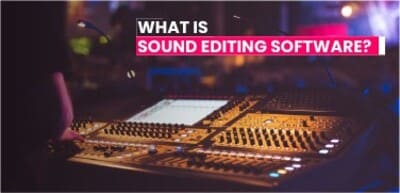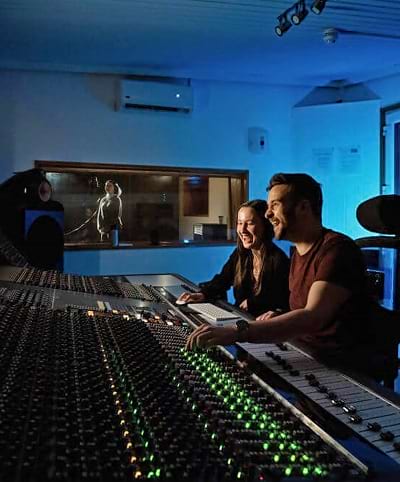What Is Sound Editing Software?
Introduction- What Is Sound Editing Software?
Before delving into the definition of sound editing software, it is essential to establish a clear understanding of what audio editing is. Audio editing software modifying and manipulating recorded sound to achieve a desired result. It involves changing various aspects of an audio file, such as adjusting volume levels, removing background noise, trimming or rearranging sections, applying effects, equalising frequencies, and more.


Audio editing is commonly performed using specialised software that allows users to manipulate and shape sound recordings to meet specific requirements or artistic goals. Sound editing software, also known as audio editing software or digital audio workstations (DAWs), is computer software designed to manipulate and edit sound recordings. It provides tools that enable users to perform various tasks, depending on which audio editing software you are using, such as editing, mixing, processing, and mastering audio.
There are several benefits of audio editing:
- Enhance audio quality: By removing background noise, improving clarity and volume, and correcting recording errors, you can ensure that your audio sounds professional and polished.
- Increase audience engagement: By using techniques such as adding music, sound effects, or dynamic transitions, you can create a more immersive experience that captures and retains the attention of your audience.
- Time and cost efficiency: Audio editing can save you time and money by providing opportunities for repurposing existing content. This allows you to maximise your content output while minimising the resources required.
In the next section, we will identify the best and easiest audio editing software options available.
Sound Editing Software
Below, you will find an extensive list of sound editing software, each offering unique features and capabilities:
- Adobe Audition
- Audacity
- AudioDirector 365
- AVS Audio Editor
- Ashampoo Music Studio
- Soundop
- FL Studio
- AudioLab
- Logic Pro X
- Pro Tools
- Ableton Live
Adobe Audition
Adobe Audition audio editing software is an all-encompassing package that offers a wide array of tools, including multitrack functionality and both waveform and spectral displays. Adobe Audition editing aims to facilitate audio content creation, mixing, editing, and restoration.
Adobe Audition system requirements can vary depending on the specific version and platform, and these requirements may change with future updates or newer versions of Adobe Audition. Here are the general Adobe Audition system requirements on Windows and macOS:
Windows:
- Processor: Multicore processor with 64-bit support
- Operating System: Windows 10 (64-bit) version 1809 or later
- RAM: 4 GB or more
- Hard Disk Space: 4 GB of available storage
- Display: 1920 x 1080 or higher resolution
- Sound Card: ASIO compatible or Microsoft Windows Driver Model
MacOS:
- Processor: Multicore Intel processor with 64-bit support
- Operating System: MacOS version 10.14 or later
- RAM: 4 GB or more
- Hard Disk Space: 4 GB of available storage
- Display: 1920 x 1080 or higher resolution
- Sound Card: Core Audio compatible
Adobe Audition audio editing offers several unique features, making it a powerful production tool. Here are some notable features of Adobe Audition:
- Multitrack Editing: Audition provides a robust multitrack editing environment that allows users to work with multiple audio tracks simultaneously. This feature is essential for creating complex audio compositions, mixing various elements, and synchronising audio with video projects.
- Spectral Frequency Display: The spectral frequency display in Audition provides a visual representation of the audio's frequency content over time. This allows for precise editing and manipulation of specific frequencies, such as removing unwanted noises or enhancing certain elements in the audio.
- Real-time Effects and Visualisation: Users can apply a wide range of real-time effects and enhancements to their audio, such as reverb, delay, EQ, compression, and more. Audition also provides real-time audio visualisation tools, including a real-time frequency analyser and audio spectrum analyser, which aid in monitoring and adjusting audio signals.

Discover how Seamedu can greatly improve and elevate your child’s skills in Sound Engineering
Hands-On Training: Engage in practical exercises that prepare your child for real-world Sound Engineering challenges.
Industry-Expert Faculty: Your child will learn from experienced professionals who bring valuable insights to the learning experience.
Networking Opportunities: Connect with industry professionals to open up career-enhancing possibilities for your child’s future.
 +91 020 46607500
+91 020 46607500
Audacity
Audacity audio editing software is a user-friendly, feature-rich audio editor and recorder available for Windows, macOS, GNU/Linux, and various other operating systems. Offering multitrack capabilities, Audacity allows users to edit and manipulate audio effortlessly. Audacity is a free and open-source sound editing software, making it accessible to all users, regardless of their budget or preferred operating system.
Audacity is versatile sound editing software that can be used in various domains. Musicians and producers use it to record, edit, and mix tracks, enabling them to fine-tune their compositions. Podcasters rely on audio editing software to enhance the quality of their episodes through features like noise removal and voice optimization. Additionally, Audacity caters to the needs of content creators, educators, and multimedia professionals for tasks such as sound editing, audio restoration, and creating sound effects.
Here are the general Audacity system requirements on Windows:
- Operating System: Windows 10, 8, 7, or Vista (32-bit or 64-bit)
- Processor: Dual-core processor, preferably 2 GHz or higher
- RAM: 4 GB or more
- Disk Space: 1 GB of available storage
- Sound Card: Windows-compatible sound card or audio interface
- Screen Resolution: 1366x768 (minimum)
- Optional: An audio interface may be required for high-quality recording or playback.
The features of Audacity are as follows:
- Recording: Audacity enables live audio recording using a microphone or mixer, and digitising recordings from other sources.
- Export / Import: You can effortlessly import, edit, and merge sound files within Audacity.
- Sound Quality: Audacity supports high-quality sound reproduction with 16-bit, 24-bit, and 32-bit audio options.
- Plug-ins: Audacity boasts compatibility with various plug-in formats, including LADSPA, LV2, Nyquist, VST, and Audio Unit.
- Effects: Experience real-time previews of LADSPA, LV2, VST, and Audio Unit effects within Audacity.
- Analysis: Audacity provides powerful analysis tools to enhance your audio editing experience, such as a spectrogram view mode for visualising and selecting frequencies, and a plot spectrum window for in-depth frequency analysis.
Audio Director 365
Audio Director is an acclaimed audio editing software that has received prestigious awards. It boasts advanced AI tools that revolutionise the process of multitracking, mixing, editing, and sound restoration.
AudioDirector offers many powerful features to enhance your audio recordings such as AI Speech Enhancement, Clean-Up Audio, Voice Profiler & EQ Match, AI Wind Removal, Vocal Balance, and AI De-Reverb.
AVS Audio Editor
What is AVS Audio Editor? AVS Audio Editor is a versatile audio editing software that provides several features for enhancing and modifying audio files. With AVS Audio Editor, users can easily cut, trim, merge, and mix audio tracks, making it ideal for creating ringtone clips, removing unwanted sections, or combining multiple audio files.
Users can transform text into a remarkably natural-sounding voice using the text-to-speech function. They can effortlessly create personalized ringtones for iPhones and other smartphones, customizing their devices with unique and catchy audio clips. Additionally, users can utilize the music editing software to master their audio, enhancing the overall sound quality and achieving higher audio refinement.
AVS Audio Editor reviews are generally positive, praising the software’s user-friendly interface, extensive features, and impressive audio editing capabilities.
Ashampoo Music Studio
Ashampoo audio editor is the “ultimate music Swiss Army knife”, providing users with a wide-ranging array of tools to simplify the process of editing, producing, trimming, mixing, and organising music and audio files. With its extensive features, users can effortlessly achieve their desired outcomes, whether it's fine-tuning tracks, creating seamless mixes, or efficiently managing their music library.
Some notable features of Ashampoo Music Studio 10 include loop support for audio previews, easy rearrangement with title bars, and a context menu for quick feature access. The Software's reviews are mainly positive, highlighting its comprehensive toolset, ease of use, and efficient music editing capabilities.
Soundop
Soundop audio editor is Windows-based and designed for recording, editing, mastering, and mixing audio. With its advanced features, Soundop empowers users to perform both waveform and spectral editing, providing comprehensive control over audio files. Despite its small package size, Soundop delivers a robust features and an optimised design, ensuring a smooth and efficient audio editing experience.
Whether you're engaged in audio creation or production, Soundop is the ideal tool to meet your needs and achieve professional-level results. Soundop audio editor reviews are generally positive, with users praising its professional features, intuitive interface, and flexible workspaces.
FL Studio
After over two decades of ongoing development, FL Studio mixer has solidified its reputation as the preferred audio editing software for numerous renowned DJs and producers worldwide. FL Studio is recognised as the ultimate conduit for swiftly translating your musical ideas from your mind to your speakers.
Here are the general system requirements for FL Studio:
- Operating System: Windows 8.1, 10 or macOS 10.13.6 or higher
- Processor: Intel or AMD processor with at least 2 GHz or higher
- RAM: 8 GB or more
- Internet: Internet connection for registration and updates
FL Studio features include the built-in mixer in FL Studio that enables users to mix and balance multiple audio tracks, apply effects, adjust levels, and create complex routing configurations, and the playlist feature that allows for arranging and organising patterns and audio clips. Thus, it enables users who know how to use FL Studio to create full-length songs with ease.
Pursue a Career in Sound Engineering.
Ready to embark on a Sound Engineering journey? Complete the form below to take your first step towards your passion.
Fill Out the FormAudioLab
AudioLab is an impressive studio that combines the capabilities of a powerful recording, mixing, and music editing software with the functionality of an audio editor. AudioLab audio editor empowers users to create personalised podcasts, record music and vocals, incorporate captivating sound effects and background noise, and seamlessly save their projects in various audio formats.
Among its many features, AudioLab includes various tools to enhance audio editing and manipulation, such as a pitch changer, high-precision zoom, and a 12-band equalizer.
Logic Pro X
Logic Pro X offers several impressive features designed to meet the needs of professional music producers. These include professional songwriting tools, tools for beat-making, editing and mixing, and a massive collection of plugins and sounds to fuel creativity.
To run Logic Pro X, you will need macOS 12.3 or a newer version of the operating system. For a basic installation, you should have at least 6GB of available space. However, if you want to install the complete Sound Library, having a minimum of 72GB of storage space is recommended. These Logic Pro X requirements ensure optimal performance and functionality when mastering Logic Pro X on your Mac computer.
Pro Tools
Pro Tools music editing software offers various plug-ins, loops, and sounds, providing musicians with an extensive toolbox for music creation. With its acclaimed DAW toolset, Pro Tools features facilitate a fast and seamless music production process. Whether you're a seasoned musician or a budding artist, Pro Tools equips you with the essential tools to bring your musical ideas to life smoothly and efficiently.
Pro Tools system requirements include:
MacOS:
- macOS Catalina 10.15.7 - Ventura 13.2.1
- M1, M2 or Intel Dual Core i5 or faster
Windows:
- Windows 10, Windows 11 (22H2)
- 64-bit Intel Core Processor
Pro Tools specs also include 8GB RAM, an internet connection, and 15GB of free space for installation and activation in all computer systems.
Ableton Live
Ableton Live, often referred to simply as Live, is a digital audio workstation available for both macOS and Windows operating systems. While the features of Ableton Live enable it to serve as a powerful tool for composing, recording, arranging, mixing, and mastering music, it also excels as a live performance instrument. Ableton Live is designed to enhance the experience of performing music in real-time, making it a versatile choice for musicians, producers, and DJs.
The latest version of Ableton Live requirements includes Windows 10 or Windows 11 or macOS High Sierra 10.13 to Ventura 13, with 8 GB RAM and approximately 3 GB disk space on the system drive for the basic installation.
Suppose you need help beginning your journey in sound editing and feeling overwhelmed by the multitude of music editing software options available. In that case, Seamedu is here to provide guidance and assistance. Seamedu assists individuals in learning various sound editing software through their educational programs and resources specifically tailored to sound editing and audio production. These programs cover a range of sound editing software, providing hands-on training and practical knowledge.
Seamedu's experienced instructors guide students through the curriculum designed to provide a blend of theoretical concepts and practical application, ensuring students develop a strong foundation in sound editing techniques.


CATEGORIES
Are you aspiring to become a proficient Sound Engineering professional?
Look no further; we are committed to nurturing the potential of young minds. Are you ready to enhance your skills?


